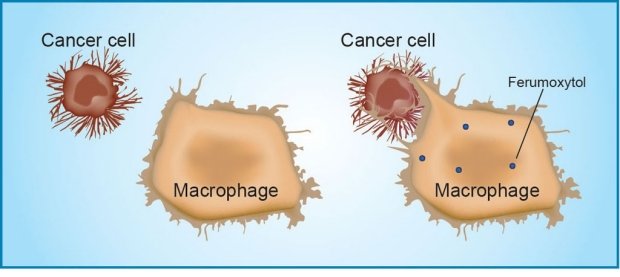Iron nanoparticles can activate the immune system to attack cancer cells, according to a study led by researchers at the Stanford University School of Medicine.
The nanoparticles, which are commercially available as the injectable iron supplement ferumoxytol, are approved by the Food and Drug Administration to treat iron deficiency anemia.

A mouse study found that ferumoxytol prompts immune cells called tumor-associated macrophages to destroy tumor cells.
Amy Thomas
The mouse study found that ferumoxytol prompts immune cells called tumor-associated macrophages to destroy cancer cells, suggesting that the nanoparticles could complement existing cancer treatments. The discovery, described in a paper published online Sept. 26 in Nature Nanotechnology, was made by accident while testing whether the nanoparticles could serve as Trojan horses by sneaking chemotherapy into tumors in mice.
«It was really surprising to us that the nanoparticles activated macrophages so that they started to attack cancer cells in mice," said Heike Daldrup-Link, MD, who is the study’s senior author and an associate professor of radiology at the School of Medicine. «We think this concept should hold in human patients, too.»
Daldrup-Link’s team conducted an experiment that used three groups of mice: an experimental group that got nanoparticles loaded with chemo, a control group that got nanoparticles without chemo and a control group that got neither. The researchers made the unexpected observation that the growth of the tumors in control animals that got nanoparticles only was suppressed compared with the other controls.
Getting macrophages back on track

Heike Daldrup-Link
The researchers conducted a series of
follow-up tests to characterize what was happening. Experimenting with cells in a dish, they showed that immune cells called
tumor-associated macrophages were required for the nanoparticles’
anti-cancer activity; in cell cultures without macrophages, the iron nanoparticles had no effect against cancer cells.
Before this study was done, it was already known that in healthy people, tumor-associated macrophages detect and eat individual tumor cells. However, large tumors can hijack the tumor-associated macrophages, causing them to stop attacking and instead begin secreting factors that promote the cancer’s growth.
The study showed that the iron nanoparticles switch the macrophages back to their cancer-attacking state, as evidenced by tracking the products of the macrophages’ metabolism and examining their patterns of gene expression.
Furthermore, in a mouse model of breast cancer, the researchers demonstrated that the ferumoxytol inhibited tumor growth when given in doses, adjusted for body weight, similar to those approved by the FDA for anemia treatment. Prior studies had shown that the nanoparticles are metabolized over a period of about six weeks, and the new study showed that the anti-cancer effect of a single dose of nanoparticles declined over about three weeks.
The scientists also tested whether the nanoparticles could stop cancer from spreading. In a mouse model of small-cell lung cancer, the nanoparticles reduced tumor formation in the liver, a common site of metastasis in both mice and humans. In a separate model of liver metastasis, pretreatment with nanoparticles before tumor cells were introduced greatly reduced the volume of liver tumors.
Potential clinical applications
The study’s results suggest several possible applications to test in human trials, Daldrup-Link said. For instance, after surgery to remove a potentially metastatic tumor, patients often need chemotherapy but must wait until they recover from the operation to tolerate the severe side effects of conventional chemo. The iron nanoparticles lack the toxic side effects of chemotherapy, suggesting they might be given to patients during the surgical recovery period.
We think this could bridge the time when the patient is quite sick after surgery, and help keep the cancer from spreading
«We think this could bridge the time when the patient is quite sick after surgery, and help keep the cancer from spreading until they are able to receive chemotherapy," said
Daldrup-Link.
The nanoparticles may also help cancer patients whose tumors can’t be completely removed. «If there are some tumor cells left after surgery, the situation that cancer surgeons call positive margins, we think it might work to inject iron nanoparticles there, and the smaller tumor seeds could potentially be taken care of by our immune system," Daldrup-Link said.
The fact that the nanoparticles are already FDA-approved speeds the ability to test these applications in humans, she added.
The new findings will also help cancer researchers conduct more accurate evaluations of nanoparticle-drug combinations, Daldrup-Link said. «In many studies, researchers just consider nanoparticles as drug vehicles," she said. «But they may have hidden intrinsic effects that we won’t appreciate unless we look at the nanoparticles themselves.»
The study’s lead author is Saeid Zanganeh, PhD, postdoctoral scholar in radiology. Other Stanford co-authors are Gregor Hutter, MD, PhD, visiting instructor in neurosurgery; Ryan Spitler, PhD, senior research scientist in radiology; Olga Lenkov, life science research assistant in the Molecular Imaging Program at Stanford; Morteza Mahmoudi, PhD, a visiting scientist in cardiology; Jukka Sakari Pajarinen, MD, PhD, postdoctoral scholar in orthopaedic surgery; Hossein Nejadnik, MD, PhD, clinical science research associate in pediatric radiology; Stuart Goodman, MD, PhD, professor of surgery; and Michael Moseley, PhD, professor of radiology.
Source:
http://med.stanford.edu/news/all-news/2016/09/iron-nanoparticles-make-immune-cells-attack-cancer.htm...




